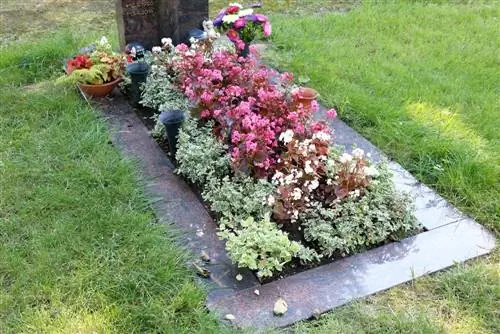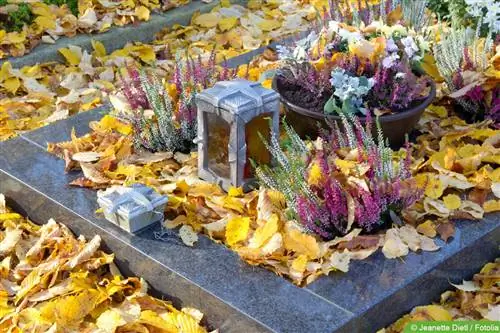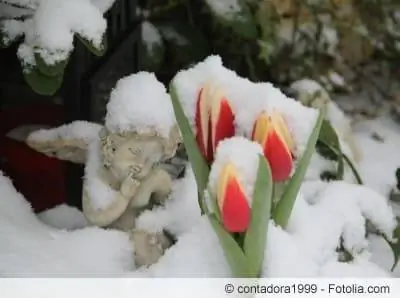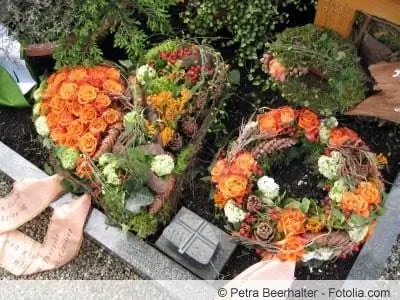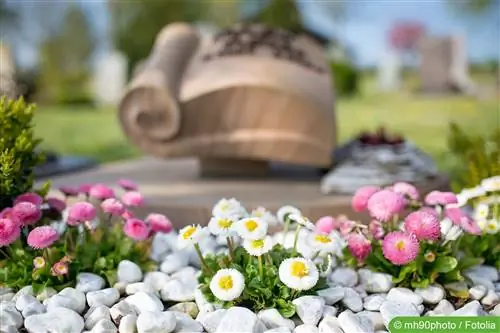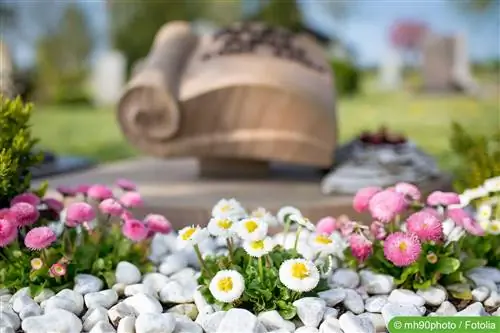- Author admin [email protected].
- Public 2023-12-17 03:39.
- Last modified 2025-01-24 12:45.
When it comes time for autumn planting, many people fall back on the same plants again and again - usually the ones that are currently on offer in discount stores. There are significantly more options for designing the grave in autumn and winter. Anyone interested can find out what is important and what is possible here.
Pay attention to quality
In autumn you can find a large number of seasonal plants in discount stores. Unfortunately, they have often spent a few days in a dark warehouse or a transporter and are therefore weakened. As a result, they often die within a short period of time. If you want to plant the plants and have something from them for longer than a few weeks, you should invest in quality and buy the plants from a nursery.
Avoid edible jewelry
Apples, pumpkins and nuts are often used in autumnal arrangements and wreaths. Unfortunately, these autumnal decorations attract not only birds but also squirrels, mice and rats. It is therefore better to avoid these decorative elements when planting graves in autumn. Alternatively, artificial variants can be used.
Color without flowers?
Colorful leafy and wintergreen perennial plants can give the grave colorful accents even without flowers. For example, purple bells (Heuchera), hosta (Hosta) and the variegated olive willow (Elaeagnus pungens 'Maculata') are well suited. The advantage of these plants is that they survive the winter well - as long as they are planted. It is only necessary to ensure that the growth of some hosta varieties may have to be limited, as they become very lush and can therefore quickly become too large, especially for urn graves.
Heide as a classic
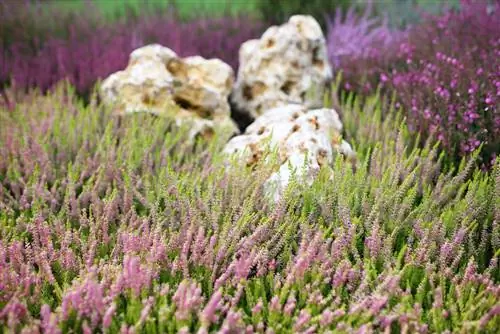
Winter-hardy varieties of heather (Erica) are autumn classics for windowsills, gardens and even the cemetery. They are available in a variety of colors from white to crimson and purple and often continue to bloom even after the first snow appears. It is particularly beautiful when different shades are combined with each other, for example a trio of white, pink and purple flowers. The small plants can also be used to form patterns and edges. Another advantage is its small size. This makes them ideal for urn graves.
Silver leaf as a durable contrast
The resilient silver leaf (Lunaria) is a wonderful contrast to the cheerfully colored heather. However, the evergreen plant can also be combined with bright yellow, orange or red flowers. When dried, it fits into autumnal arrangements and wreaths and also looks very decorative in bowls.
Classic flowering plants for the grave
The classic flowering plants for autumn planting in the cemetery include:
- Cyclamen
- Asters
- Chrysanthemums
- horn violets
- Pansies
- Strauchveronika
- Cyclamen
They all bring colorful accents to the grave planting in autumn, are available in numerous different tones and are comparatively easy to care for. They can also be easily combined with each other. If there is not much time left for grave care, preference should be given to cyclamen and horned violets. They are undemanding, bloom in autumn and are among the first plants to sprout buds and flowers again in spring. Apart from that, there are simple and double, multi-colored, large and small-flowered varieties. This can ensure variety even if only cyclamen and horned violets are planted on the grave as flowering plants.
Grasses as an accent
Integrating grasses into the grave planting seems unusual at first. However, the plants add an accent and make the planting more dynamic thanks to a small difference in height. In addition, some species bloom in autumn and are also hardy.
However, care should be taken to select grass species that remain small and to limit their spread. It is therefore better to put the grasses in a bowl or pot or to integrate a root barrier. In addition, the ears of corn should be cut off after drying so that the seeds cannot spread in the surrounding area.
Suitable small species and varieties include:
- Blue fescue grass
- Japanese blood grass
- Calmus
- Small Pennisetum Grass
- Pipegrass
- Flatgrass
- Sedges, such as red sedge and Japanese sedge
- Prickly Fescue
Integrate panels
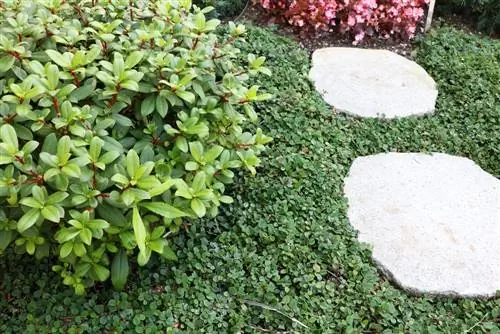
If the grave is not to be replanted two to three times a year but is still to be decorated with changing flowering plants, the combination of ground cover and slabs is ideal. The ground cover plants are the basis of the planting and serve as a background. Planted bowls can be placed on the plates or wreaths and arrangements can be placed, which act as seasonal embellishments and points of color. Plant decorations in the cemetery are made much easier by the combination of leaves and planted bowls; weeding is only necessary on the plates and other care is limited to watering and removing the leaves.
Leave gaps
A lush planting consisting of dense ground cover plants and some flowering accents can be a beautiful sight. However, such lushly planted graves often require a lot of care. An alternative to this is to consciously leave space. Planting at the edge, colored accents or planted bowls in the middle and free areas filled with gravel or mulch create a very tidy and well-kept picture - without having to forego the seasonal plant decorations. Watering and trimming the plants is just as easy as removing leaves. In addition, individual plants are shown to their best advantage.
Less is more
Ten different plants in ten different colors, shapes and sizes - this can quickly make graves appear cluttered. When planting, the following applies:Less is more The choice of plants should be limited to three to five different varieties. The same applies to very different colors. If the design is kept tone-on-tone, there may be more nuances.

